|
The interaction between Teotihuacan in central Mexico and Kaminaljuyu in Guatemala had a significant although short-lived impact on local architectural styles and elite burial patterns at the latter site. Evidence suggests that most of the individuals interred in the thirteen tombs in these two mounds were Maya who adopted and adapted highland Mexican behaviors as a statement of political power. The few artworks from these tombs that were made in the Mexican highlands suggest that Teotihuacan individuals married into Kaminaljuyu's dynasty to solidify their position within this powerful Maya center.
The incised tripod vessel at right was found in a tomb, which had been created inside Mound A during a rebuilding phase that featured Maya-style architecture and burial traditions. The tomb chamber was used for many decades, and it contained at least eight individuals. The last person interred was a woman, the only female among the thirteen tombs. Around her were numerous objects, including this incised vessel. This tripod form is associated with Teotihuacan ceramic traditions, yet its elegant out-curving walls and decorative program are Maya in style and narrative content. This woman may have been joined in a royal marriage between Kaminaljuyu and Teotihuacan's ruling elite. |
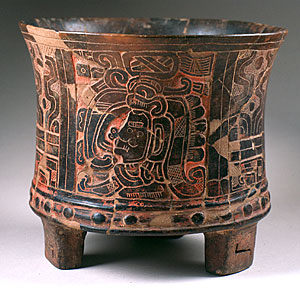
Tripod Vessel. |
| Two tombs in Mound B epitomize a new burial pattern that recalls that of Teotihuacan, in which the interred were usually placed in a seated position. Burial offerings included both local and foreign artifacts from other Maya areas, Veracruz, and Central Mexico. New types of offerings, which also recall Teotihuacan, include offering bowls (instead of the Maya-style cache vessels), dog skeletons, shell eye rings, and mosaic disks. Tomb B-1 is the most "Teotihuacan" of the thirteen burials. The tomb contained three individuals dressed as Teotihuacan warriors, with Tlaloc-like shell rings on their foreheads or over their eyes. |
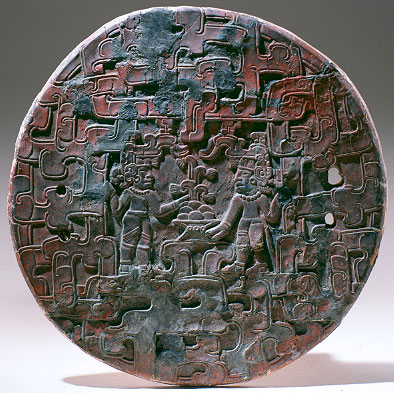
|
The Veracruz-style mirror at left was worn by Skeleton 2. It depicts two figures facing each other across a vessel that may contain food or copal. Carved Mirror Back. Guatemala, Kaminaljuyu, Mound B, Tomb B-1. AD 400-500. Slate with pigment. 19.2 cm. Museo Nacional de Arqueología y Etnología, Guatemala City. |
|
Although Tomb B-II resembles Tomb B-1, only two of the six stucco-painted tripod vessels found in the tomb were decorated in Teotihuacan style; the other four were embellished with Maya motifs and narratives. Thus lidded tripod vessel (detail at right) shows a king dressed in Teotihuacan style but with Maya jewelry. Lidded Tripod Vessel (detail). Guatemala, Kaminaljuyu, Mound B, Tomb B-I1. AD 400-500. Ceramic with stucco and pigment. 29.5 x 15.2 cm. Museo Nacional de Arqueología y Etnología, Guatemala City. |
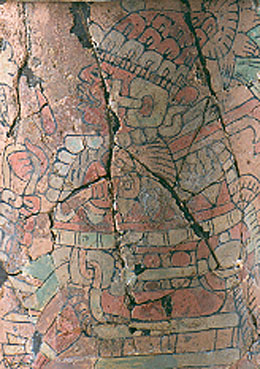
|
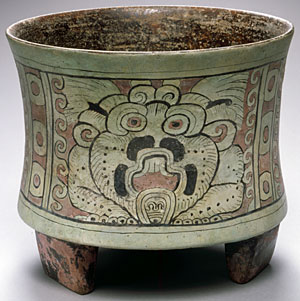
|
The hybrid aesthetic is particularly well represented by the stucco-and-painted tripod vessel at left. Although the vessel's shape and tripod supports indicate that it likely originated in a Maya workshop, it is decorated with a Teotihuacan-style supernatural jaguar devouring a human heart and surrounded by life-giving water/blood. Tripod Vessel with Image of Two Plumed Jaguar Heads. Maya area. AD 400-650. Ceramic with stucco and pigment. 20.3 cm. The Princeton University Art Museum. |
Thin Orange, a hallmark of Teotihuacan pottery, has characteristic orange color and very thin walls. Chemical analysis has identified its origins in the state of Puebla, to the east of Teotihuacan. Thin Orange pottery has been found in late-fourth-centuryu burials at a number of Maya sites, including Kaminaljuyu, Copan, and Tikal, although some of these are local reproductions. The burials from Kaminaljuyu's Mounds A and B that most closely follow Teotihuacan funerary patterns contained dog skeletons (Tombs A-VI, B-I, B-II) or the Thin Orange ceramic dog effigy at right (Tomb A-III). Among the Aztec and other highland Mexican peoples, dogs guided souls on their journey through the underworld. The similarity between the Kaminaljuyu canine effigy and one from the Mexican highlands (in the collections of the Los Angeles County Museum of Art) suggests that it was imported from Mexico. |
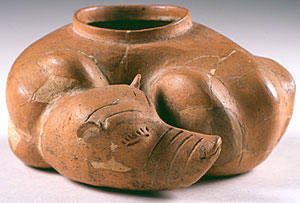
Vessel in Form of Dog. |
|
References: Smith, A. Ledyard, and Alfred V. Kidder. 1943. Explorations in the Motagua Valley, Guatemala. Contributions to American Anthropology and History 41. Carnegie Institution of Washington 546. Washington, D.C. Kidder, Alfred V., Jesse D. Jennings, and Edwin M. Shook. 1946. Excavations at Kaminaljuyu. Carnegie Institution of Washington Publication 561. Washington, D.C. Santley, Robert S. 1983. "Obsidian Trade and Teotihuacan Influence in Mesoamerica." In Miller, Highland-Lowland Interaction, 69-124. Wright, Lori E. 1998. "Los Niños de Kaminaljuyu." In XII Simposio de Investigaciones Arqueológicas en Guatemala. 2 vols. Guatemala: Instituto de Antropología e Historia. Reents-Budet, Dorie and T. Patrick Culbert. 1999. "Las ofrendas del período Clásico Temprano de Tikal y Kaminaljuyu." Paper presented at the XIII Simposio de Arqueología y Etnología de Guatemala, Museo Nacional de Arqueología y Etnología, Guatemala City. Reents-Budet, Dorie, Juan Antonia Valdéz, Ronald L. Bishop, and Jim Blackman. 2004. "La cerámica de Kaminaljuyu." Paper presented at the XVIII Simposio de Investigaciones Arqueológicas en Guatemala, Museo Nacional de Arqueología y Etnología, Guatemala City. |
Copyright 2005 Los Angeles County Museum of Art